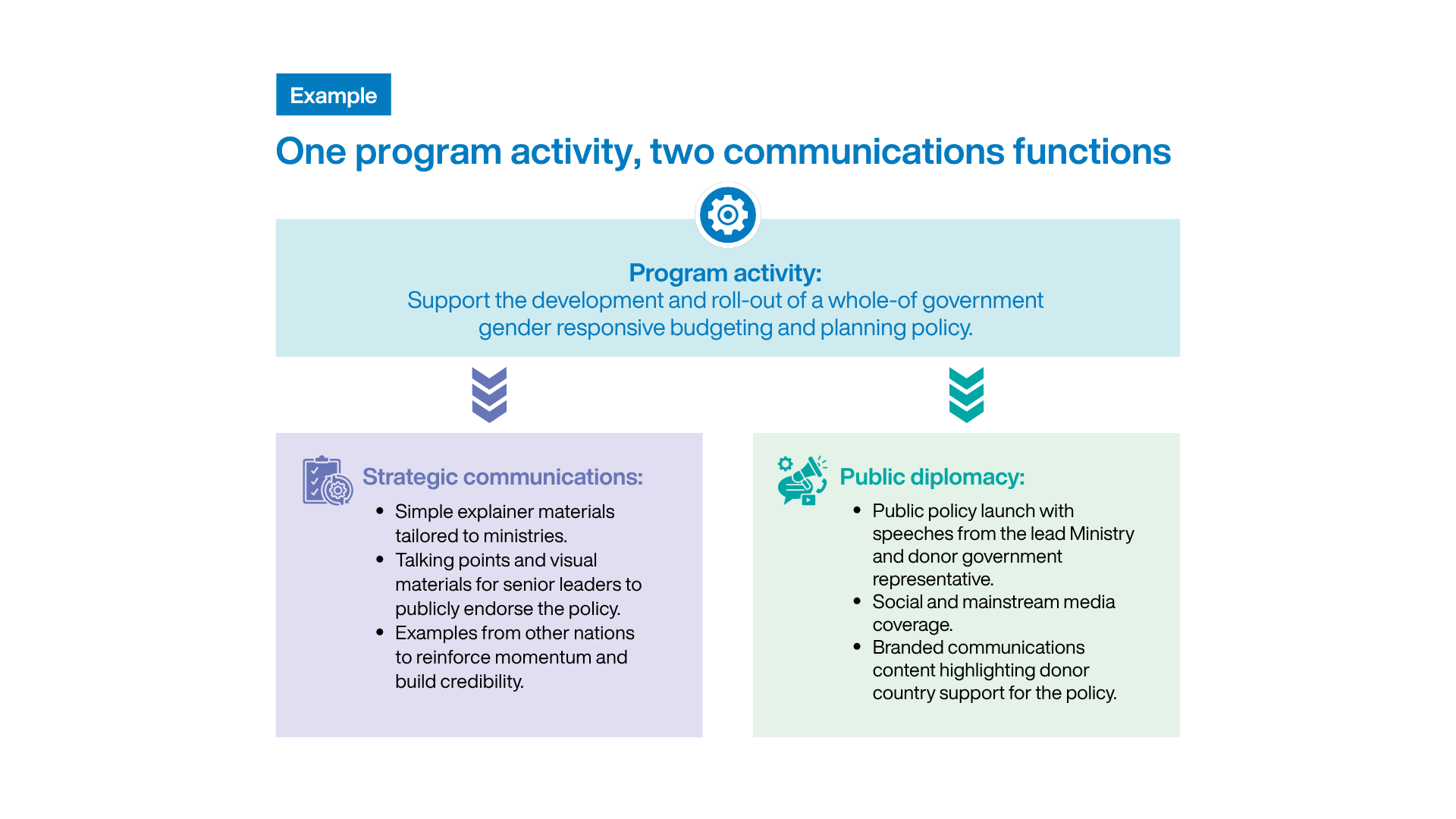Public diplomacy and strategic communications are not the same – and it matters
By Lisa Ritchie, Communications Strategist and Founder of EngagingDev
If you work in development program delivery, this article clarifies two powerful – but often confused – streams of program communications that shape perception, partnership and impact.
In the world of development, the term communications covers many tactical and strategic skills and purposes, but it is important to recognise there is no single, catch-all function.
Within the bilateral development program landscape, there are distinct communications disciplines with different objectives, audiences and measures of success. Two of the most critical, and often confused, are contributions to a donor’s public diplomacy efforts and a program’s strategic communications.
Understanding their differences is not just a matter of semantics, but is essential to making development programs more effective.
What is public diplomacy?
Public diplomacy is how a country communicates with foreign publics to influence perceptions and advance its national interest. In the development context, this often means telling the story of a donor’s contributions to economic and social development – showcasing generosity, shared values and diplomatic partnership.
It’s about soft power – building trust, fostering goodwill, and highlighting how a donor nation is a responsible, values-driven global citizen. Public diplomacy content is typically high-visibility, emotionally-resonant, and designed to reflect positively on the donor country.
In development programs, public diplomacy takes the form of branded content, high-profile and public launches, social media and mainstream media coverage, and public visibility through other events and site visits. All of these activities often create an opportunity for the donor government to publicly engage with local stakeholders, including partner governments. Public diplomacy is often geared toward demonstrating partnership and impact in ways that resonate with the audience in a country of operation while also communicating relevance back to domestic audiences.
What is strategic communications?
Strategic communications, by contrast, is embedded in program delivery to foster engagement, build understanding of program goals and help achieve them.
It often operates behind the scenes, supporting government and other partners to lead, collaborate and advance their own priorities. This can include working through partner-led channels to amplify government initiatives, support advocacy by civil society actors, or communicate sensitive reform messages that may not be appropriate coming directly from donor government channels.
Strategic communications may also involve targeted efforts to build awareness and understanding among stakeholders, or to reflect community and partner insights back to key actors, including donors, to influence decision-making, policy development or program adjustments.
It is focused on behaviour change, stakeholder alignment and reform uptake. Its success is measured by program outcomes, not by media impressions or social sentiment.
Unlike the visibility-driven nature of public diplomacy, strategic communications is grounded in evidence, aligned to context, and focused on reform. It unpacks complexity, doesn’t shy away from what didn’t work, and plays a vital role in achieving development outcomes – often without the spotlight.
Different tools, different outcomes
Here is a quick side-by-side to show you how public diplomacy and strategic communications differ across purpose, audience and impact.
Why removing the confusion matters
Too often, public diplomacy and strategic communications are treated as interchangeable. The result? Communications teams are often pulled in different directions: torn between showcasing donor contributions and supporting real-time reform implementation. Furthermore, when program teams don’t understand or appreciate the difference, strategic communications becomes challenging to implement as it is less visible, less understood and, as a result, not valued.
Public diplomacy cannot replace the deep, technically grounded communications needed to drive change. And strategic communications is not strategic if it is only considered in the context of a donor’s public diplomacy efforts and the good news stories. While a program can and should contribute to the public diplomacy efforts of a donor, it is important that this does not come at the expense of the strategic support for program objectives. If programs don’t deliver results, the associated public diplomacy risks being nothing more than spin.
The example below presents strategic communications activities in support of a new gender-responsive budgeting policy roll-out, and the public diplomacy opportunities that would emerge as the policy was launched. The strategic communications would be delivered with and through relevant government systems, while the public diplomacy efforts would focus on donor partner support, messaging and channels.
Making the relationship work
Public diplomacy and strategic communications can, and should, coexist in a program’s communications strategy. But they must be clearly defined, separately resourced, and strategically aligned. Public diplomacy can leverage the results that strategic communications helps make possible. Strategic communications, meanwhile, can benefit from the visibility and goodwill among partners that public diplomacy can generate.
Both require skilled strategists and communicators. Both need clarity of purpose. And both are too important to be muddled together.
At EngagingDev, we help programs design communication strategies that differentiate a donor’s public diplomacy from a program’s strategic communications, ensuring each is aligned with the program’s purpose, audience and impact goals. For the detail on why, see Beyond the Good News: Why strategic communications in development matters.
The takeaway
Development communication is not one-size-fits-all. When we confuse public diplomacy with strategic communications, we dilute the value of both. But when we understand and invest in each discipline appropriately, we strengthen program outcomes and both program and donor reputations alike.


